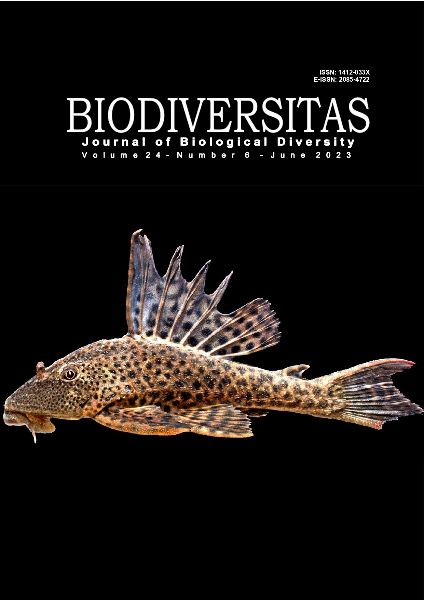Termite diversity and abundance based on altitude in Mount Ungaran, Central Java, Indonesia
##plugins.themes.bootstrap3.article.main##
Abstract
Abstract. Subekti N, Milanio RR. 2023. Termite diversity and abundance based on altitude in Mount Ungaran, Central Java, Indonesia. Biodiversitas 24: 3332-3337. Termites are social insects whose main diet is the cellulose and lignocellulose found in rotting wood and in some fungi. As the Mount Ungaran area in Central Java, Indonesia, has been converted to agriculture and other purposes, termite habitat has become increasingly narrow, with a reduction in the insects’ food sources. The purpose of this study was to analyze the species of termites found on Mount Ungaran and the factors that influence their lives. In addition, the differences in species according to slope (north, south, east, and west) and altitude were assessed. This research was conducted in three stages: termite collection, termite identification, and data analysis. The main species found in this study were Coptotermes curvignathus Holmgren, 1913, Odontotermes javanicus Holmgren, 1912, Macrotermes gilvus Hagen, 1858, Nasutitermes matangensis Haviland, 1898, and Bulbitermes constrictiformis Holmgren, 1914. Based on a Shannon-Wiener analysis, the west slope had the highest diversity index, which was primarily influenced by four environmental factors (soil pH, soil temperature, soil moisture, and rainfall). In the canonical relationship correspondence analysis, soil pH, light intensity, and canopy cover were the environmental factors that most affected the diversity and abundance of termites on Mount Ungaran. The conclusions that can be drawn from this study are that termite richness varied between slopes and the environmental factors that were the most associated with the variation were soil pH, light intensity, and canopy cover.
##plugins.themes.bootstrap3.article.details##
Most read articles by the same author(s)
- NIKEN SUBEKTI, ISMA NURVAIZAH, JAN HENDRIEK NUNAKI, HENGKY LUKAS WAMBRAU, Biodiversity and distribution of termite nests in West Papua, Indonesia , Biodiversitas Journal of Biological Diversity: Vol. 19 No. 5 (2018)
- APRI HERI ISWANTO, DWIVIA WAHYU AMANDA, SAHARMAN GEA, ARIDA SUSILOWATI, WIDYA FATRIASARI, ATMAWI DARWIS , M. ADLY RAHANDI LUBIS, TITO SUCIPTO, SYAHIDAH, NIKEN SUBEKTI, RUDI HARTONO, JAJANG SUTIAWAN, WAHYU HIDAYAT, NAM HUN KIM, Characteristics of Simalambuo (Lophopetalum sp.) wood from Nias Island, North Sumatra Province, Indonesia , Biodiversitas Journal of Biological Diversity: Vol. 24 No. 7 (2023)

